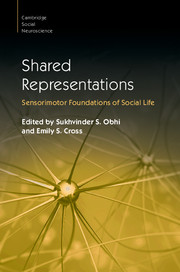Book contents
- Shared Representations
- Cambridge Social Neuroscience
- Shared Representations
- Copyright page
- Contents
- Figures
- Tables
- Boxes
- Contributors
- Preface
- Part I Foundations
- Part II Imitation and Mimicry
- 6 The Comparative Study of Imitation Mechanisms in Non-Human Primates
- 7 The Cultural Transmission of Social Information
- 8 The Control of Shared Representations and Social Cognition
- 9 Neurocognitive Explorations of Social Mimicry
- Part III Thinking, Perceiving and Acting with Others
- Part IV Understanding Others
- Part V Learning and Development
- Part VI Shared Representations in Applied Contexts
- Index
- Plate Section (PDF Only)
- References
9 - Neurocognitive Explorations of Social Mimicry
from Part II - Imitation and Mimicry
Published online by Cambridge University Press: 27 October 2016
- Shared Representations
- Cambridge Social Neuroscience
- Shared Representations
- Copyright page
- Contents
- Figures
- Tables
- Boxes
- Contributors
- Preface
- Part I Foundations
- Part II Imitation and Mimicry
- 6 The Comparative Study of Imitation Mechanisms in Non-Human Primates
- 7 The Cultural Transmission of Social Information
- 8 The Control of Shared Representations and Social Cognition
- 9 Neurocognitive Explorations of Social Mimicry
- Part III Thinking, Perceiving and Acting with Others
- Part IV Understanding Others
- Part V Learning and Development
- Part VI Shared Representations in Applied Contexts
- Index
- Plate Section (PDF Only)
- References
Summary
Social mimicry is the ubiquitous tendency to copy the bodily movements, expressions, postures and speech patterns of an interaction partner. Since the 1990s social psychologists have studied this phenomenon intensively and have revealed many interesting findings about the factors that moderate mimicry and its consequences. Recently, social cognitive neuroscientists have also begun to study mimicry, with an emphasis on uncovering its mechanistic underpinnings. In particular, mechanisms that have been studied in tasks such as action observation and automatic imitation have been assumed to play a role in social mimicry. Although intuitive, the notion that these mechanisms are common to both tightly controlled laboratory tasks and more naturalistic social mimicry is an assumption that requires empirical investigation. Here, I present recent work that begins to provide this missing empirical link. I contextualize this work with respect to both the social psychology and the cognitive neuroscience literatures.
- Type
- Chapter
- Information
- Shared RepresentationsSensorimotor Foundations of Social Life, pp. 171 - 192Publisher: Cambridge University PressPrint publication year: 2016
References
- 2
- Cited by

